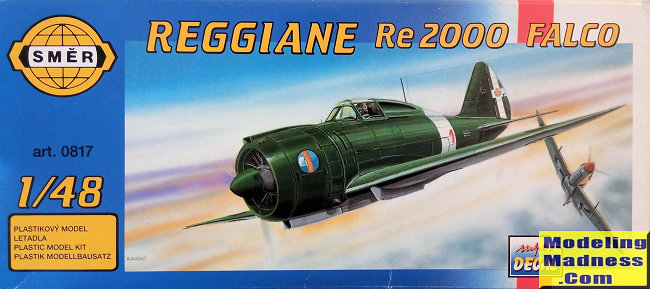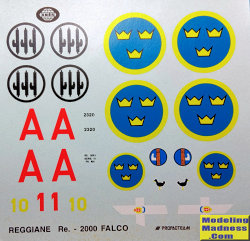
SMER 1/48 Re.2000 Falco
| KIT #: | 0817 |
| PRICE: | €5.00 in 2007 |
| DECALS: | Two options |
| REVIEWER: | Spiros Pendedekas |
| NOTES: | Kit is actually 1/50 |

| HISTORY |
Designed as a light highly maneuverable interceptor/fighter aircraft, the Reggiane Re.2000 Falc bore substantial similarities to the Seversky P-35. From its maiden flight the plane showed very positive potential, being able to outfight several significant combat aircraft of the time, including the Macchi MC 200 and even the Bf 109E. During the run up to and following the outbreak of the Second World War, the aircraft was ordered by several nations, including the Hungarian, Swedish, British and Italian governments.
Interestingly, this very potent technically advanced aircraft was unfavored by the Italian Air Ministry, due to the latter’s judgment that the plane’s integral wing fuel tanks were so designed that they would be highly vulnerable and prone to leaks, as well as being difficult to manufacture, with Regia Aeronautica consequently rejecting the type and even canceling its pre-production order.
Still, the Italian government authorized Reggiane to promote the type for sales on the global market to international customers, effectively offering the programme a reprieve. Enthusiastic, the company decided to proceed with the production of the original batch of previously canceled 188 fighters as a private venture so that immediate delivery could be offered to foreign customers.
Accordingly, the Re.2000 was much more prominently used by the Hungarian and Swedish air forces than by the Regia Aeronautica at home. In fact, 80 per cent of the total Re.2000 production went to these two countries.
| THE KIT |
 Though
marketed as 1/48, this is actually the 1/50 ancient 70s Artiplast mold, that has
been regularly reboxed by SMER ever since with occasionally different decals and
offered at very low prices. The subject kit is the mid-2000s edition,
bought from my usual hometown’s toy/hobby shop in 2007. The kit comes in the
typical flip opening SMER small box, carrying an attractive box art of artist
Vladimír Suchý, depicting a bird belonging to Aviazione Ausillaria per la Regia
Marina, intercepting a Spitfire V trop.
Though
marketed as 1/48, this is actually the 1/50 ancient 70s Artiplast mold, that has
been regularly reboxed by SMER ever since with occasionally different decals and
offered at very low prices. The subject kit is the mid-2000s edition,
bought from my usual hometown’s toy/hobby shop in 2007. The kit comes in the
typical flip opening SMER small box, carrying an attractive box art of artist
Vladimír Suchý, depicting a bird belonging to Aviazione Ausillaria per la Regia
Marina, intercepting a Spitfire V trop.
Upon opening the box, I was greeted with 43 light gray styrene parts, all
arranged in two sprues but the two fuselage halves, which are provided
separately. Molding shows its age, with large amounts of flash practically
everywhere, mold shifts, with the thick sprue gates penetrating into parts,
sometimes in a most unpleasant manner (like ruining one of the prop blade tips).
External details are all over raised with lots of rivets typically found on kits
of the era.
Cockpit is as basic as it can get, with the tub and instrument panel at least
featuring generic and simplistic instrument detail. An equally plain seat is
given, together with a stick and what looks to be an oxygen bottle. The pilot
provided is too crude to be usable, better modify/fit a leftover one from your
Tamiya Spitfire if you decide to place one in (who will hide a good deal of the
cockpit sparseness).
The engine, a very prominent feature of the Falco, is provided as a dual
cylinder row affair with molded on push rods, looking soft and plain on details
and the same can be said for the cowling, the prop and main landing gear parts
and bays. Regarding the rear wheel, its doors are provided but there is no bay
to speak off, just a hole where you are supposed to attach the rear leg. This is
an oversimplification of the kit and has to somehow be addressed by cutting the
fuselage and creating some sort of bay or even a void, as it will look weird if
left as is, upon viewing the model’s undersides.
Transparencies are thick, not clear and have mold imperfections. Though provided
as separate pieces, I believe going for a closed option is the wisest thing to
do, avoiding exhibiting neither their thickness nor the cockpit’s sparseness. My
kit had a spare windshield. Instructions come in the form of a b/w two-sided
leaflet, including a brief history of the type and a seven-step construction
sequence, which is as simple as the kit itself is.
 Two schemes
are provided, for an Italian Aviazione Ausillaria per la Regia Marina dark green
over light gray example and a Swedish one, carrying an attractive scheme of dark
green topsides, segregated by yellow sand thin lines, with light blue undersides
and red cowling lip and spinner. Decals are sharply printed by Propacteam and
are very thin. They still look usable (though you can never know unless you
apply them). Having used Propacteam decals of the era, I recall them being very
intolerable in handling once applied and easily folding to themselves. If
applied carefully, though, they would yield excellent results.
Two schemes
are provided, for an Italian Aviazione Ausillaria per la Regia Marina dark green
over light gray example and a Swedish one, carrying an attractive scheme of dark
green topsides, segregated by yellow sand thin lines, with light blue undersides
and red cowling lip and spinner. Decals are sharply printed by Propacteam and
are very thin. They still look usable (though you can never know unless you
apply them). Having used Propacteam decals of the era, I recall them being very
intolerable in handling once applied and easily folding to themselves. If
applied carefully, though, they would yield excellent results.
Instructions want you to first assemble the cockpit and the main gear legs, then
join the fuselage halves and attach the horizontal stabilizers. The engine is
next to be assembled and attached to the cowling, followed by the prop. The main
wing follows, onto where the cockpit tub is affixed and the complete assembly is
to be attached to the fuselage. By the looks of things you should expect massive
gaps there. The complete engine with the prop, the landing gear, the top antenna
mast and the transparencies are finally attached, ending an uncomplex build (but
“uncomplex” does not always mean “uncomplicated” and this looks to be a classic
case of a kit that will possess a good degree of complication during
construction).
| CONCLUSIONS |
With the excellent (and very
sensibly priced) Special Hobby and the forthcoming Italeri 1/48 kits, it is
totally clear which way the modeler has to go, in order to come up with an
accurate quarter scale representation of the charming Italian fighter.
The SMER kit, apart from being 1/50 (which might be an issue to a number of
modelers), is definitely old school, simplistic in details and with the molds
showing their age. Transparencies are not great either, All parts will require
a significant amount of clean-up and fit is expected to be challenging,
especially at the fuselage/wing joint.
Instructions are followable, with the excellent decal sheet saving the day.
True, the kit is cheap (can be found at roughly one third of the Special Hobby),
so this makes it sort of an option offered to the modeler willing to do an
amount extra work, including parts cleaning, tackling the kit’s fit
challenges and possibly adding some extra detail, in order to come up with an
acceptable result.
Happy modeling!
Spiros
Pendedekas
April 2023
Copyright ModelingMadness.com. All rights reserved. No reproduction in part or in whole without express permission.
If you would like your product reviewed fairly and fairly quickly, please contact the editor or see other details in the Note to Contributors.